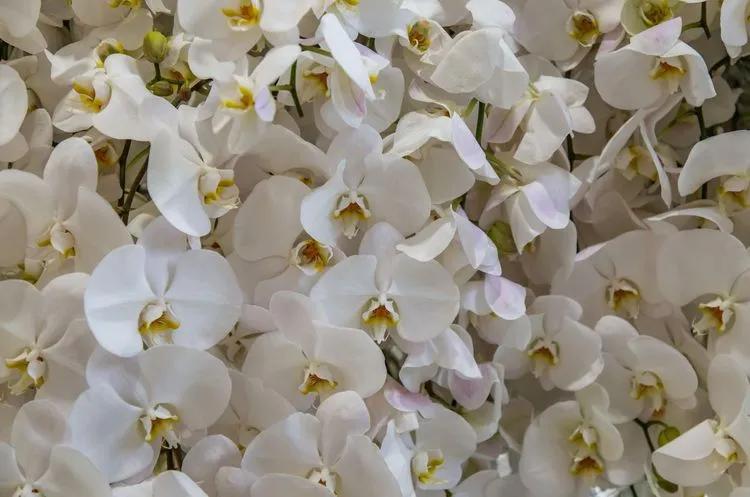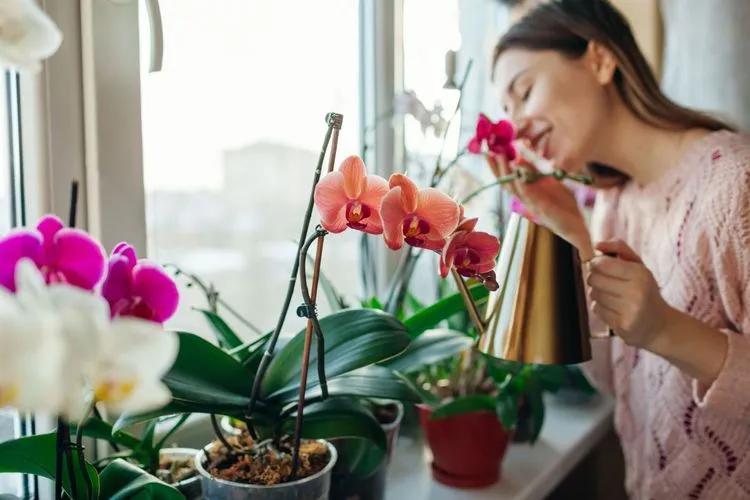 Orchidaceae family, commonly known as orchids, includes several hundred different genera and thousands of species. However, most houseplanting fans get to know this family caring for the plants of the Phalaenopsis genus. These are thick-leaved plants with arching sprays of flowers. Phalaenopsis are not demanding, and following an easy care routine, they will bloom for months even when the other plants get dormant.
Orchidaceae family, commonly known as orchids, includes several hundred different genera and thousands of species. However, most houseplanting fans get to know this family caring for the plants of the Phalaenopsis genus. These are thick-leaved plants with arching sprays of flowers. Phalaenopsis are not demanding, and following an easy care routine, they will bloom for months even when the other plants get dormant.
Overview
Phalaenopsis orchids are epiphytes which means that in their natural habitat, they live on other plants, usually trees. However, unlike parasites, they don’t harm their hosting plant and use it strictly for physical support. This is why potted orchids are always sold with special supporting sticks. Another interesting feature of epiphytes is that they don’t have ordinary roots. They obtain special aerial roots and get nutrients and water directly from the environment, with no soil need. Thus, phalaenopsis needs proper air circulation between the roots.
In US hardiness zones 10 to 12, phalaenopsis can be grown outdoors in well-lit places with no direct sunshine. More often, these plants are grown as potted houseplants in pots in any climate. Their long-lasting flowers cling to curved branches and unfold sequentially. A single peduncle with many branches can have more than 20 flowers, and individual flowers of various colors can last for weeks.
Light
 To place a flowerpot, it is recommended to choose an east, west, or northeast window. If a south-facing window is your only option, place the plant, not on the windowsill but at least 1 meter away from it. It is essential to cover the window with a curtain so that slight shading is created. Direct sun rays cause burns on the surface of the flowers and foliage. To prevent the orchid from growing tilted to one side, rotate the pot once every 15–20 days. However, avoiding disturbing the plant during the formation of buds; it might affect blooming.
To place a flowerpot, it is recommended to choose an east, west, or northeast window. If a south-facing window is your only option, place the plant, not on the windowsill but at least 1 meter away from it. It is essential to cover the window with a curtain so that slight shading is created. Direct sun rays cause burns on the surface of the flowers and foliage. To prevent the orchid from growing tilted to one side, rotate the pot once every 15–20 days. However, avoiding disturbing the plant during the formation of buds; it might affect blooming.
Temperature
The plant blooms in a shaded place at a temperature of 64-77˚F (18-25˚C). However, it can withstand the heat up to 108˚F (42˚C) or the cool of 54˚F (12˚C) for short periods. However, this should not be overused since phalaenopsis won’t develop and bloom properly within these temperature extremes.
Watering
 Water the flower only after the substrate is completely dry, but don’t let the plant to remain dry for a long time. Usually, orchids are grown in transparent pots, so you can check the walls: if there is no moisture on them, it is a signal for watering. If the plant does not receive enough water, the color of the green roots becomes paler.
Water the flower only after the substrate is completely dry, but don’t let the plant to remain dry for a long time. Usually, orchids are grown in transparent pots, so you can check the walls: if there is no moisture on them, it is a signal for watering. If the plant does not receive enough water, the color of the green roots becomes paler.
During waterings, pay attention not to spill the water directly on the foliage. We recommend watering from the bottom. Water used for irrigation should be soft and clean. Distilled water is also suitable. Once every 4 weeks, shower your phalaenopsis or rinse it instead.
Don’t overwater the flower as it will lead to fading color of the foliage and rotting of the growth point. If it happens, the shoot might regrow, but it can also lead to the death of the plant, so be careful.
Air humidity
The air humidity should not be too high; 30-40% will do just well. Since the plant is an epiphyte, the room should be well ventilated. If the humidity is too low, the foliage will lose its turgor, and the flowers will fall off. To prevent this, increase the humidity level by placing the pot on a pallet filled with moistened pebbles. The pot itself shouldn’t touch the water since it can lead to overwatering.
On the other hand, excessively high humidity causes root rot and specks on the foliage. Our experts do not recommend misting orchids even in very intense heat since the liquid flows into the leaf sinuses and can provoke rotting. Also, the presence of water on the plant can trigger sunburns.
Fertilizer
 Feed the plant during waterings using liquid fertilizers twice a month. Choose fertilizers that contain equal amounts of nitrogen, phosphorus, and potassium. It could be 10-10-10 or 20-20-20 proportion, look for it on the label of a product. There are special orchid fertilizers, but a universal flowering one is also a good choice. Always dilute the recommended dose of fertilizer in two as too high an amount of nutrients is even more harmful than their lack.
Feed the plant during waterings using liquid fertilizers twice a month. Choose fertilizers that contain equal amounts of nitrogen, phosphorus, and potassium. It could be 10-10-10 or 20-20-20 proportion, look for it on the label of a product. There are special orchid fertilizers, but a universal flowering one is also a good choice. Always dilute the recommended dose of fertilizer in two as too high an amount of nutrients is even more harmful than their lack.
